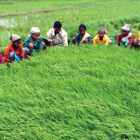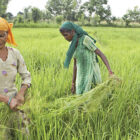As the farmer becomes irrelevant in the political sphere and the urban electorate gains prominence, the government takes sides to retain power.
It hurts everyone every single day; almost every hour. It would be good to be able to say that it is not visible to the eye. However, one cannot, any longer fail to recognise the fact that something as essential as ‘daal’ has disappeared from the poor person’s diet of ‘daal roti’. Even the middle-class Indian is finding it hard to afford it. Understanding food inflation is no less difficult than controlling it. On the one hand, food prices continue to rise and, on the other, the farmer’s share of the price that the consumer pays keeps falling.
In the first term of the UPA government, the left parties were blamed for blocking reforms and the continuation of excessive regulations that prevented policy measures from being implemented to protect the aam aadmi. In the second term, there were no restrictive ideologies to hold back firm government action. Even so, the government has been unable to control prices. The average food inflation in the last four years has been raging from nine per cent to 17 per cent.
Economists glibly attribute food inflation to the strong growth of the Indian economy using arguments that are far from convincing. While high growth could be a restricting factor in efforts to control price rise; it can never be an untameable factor. China, which has grown at a higher rate of growth for decades, not just years, has had no problem with food inflation for most of the years. Growth is good but if growth is responsible for the suffering of the masses, the same economists who expect to be lauded for accomplishing growth should rather hang their heads in shame for failing on the inflation front.
Whither inclusive growth
It is necessary to examine who gets affected by a price rise especially under a regime with ‘inclusive growth’ as its mantra. The farmers comprise the largest section of Indian society and are, therefore, the worst affected. They are enjoined, besides, to produce food for the country even when the bulk of them are, invariably, without the wherewithal to have two square meals a day. This farming population also includes the landless agriculture labour working in the fields, who not only face a problem with food but also fuel. Wood or organic matter for cooking, which was free for thousands of years, has been commoditised now and has a value because of the demand generated by the alternative fuel industry. This is a lesser understood problem and demands greater scrutiny in terms of its implications for landless rural people given government policies on alternative fuel. Analytical studies on social impact are not a favourite subject of economists and planners.
Why food inflation
Food inflation happens because of a multiplicity of factors, including – and not limited to – an increase in input prices, misdirected and uncoordinated policies, inadequate allocation of funds for agriculture research, collapse of extension services – in other words transferring this research from the laboratory to the land – marketing laws, existing monopolies, limited choices and access to the farmers and consumers alike. These issues can only be resolved over a long term and with committed action.
In the short term, it boils down to sheer bad governance of various governments, at the centre or at the state levels over several years. Fruit and vegetables, for instance, are perishable and basically responsible for the recent hike in food inflation. The difference in the price of fruit and vegetables from farmgate and the price at which the consumer buys it, is possibly the highest in the world. Policy intervention can reduce this gap and prices can actually fall substantially. Changing tack of the Agricultural Produce and Marketing Committee Act will also help.
Compounding the problems
Simple solutions elude policymakers, possibly due to coordination problems because agriculture is a state subject. Preference, incentives and subsidies for a limited number of crops, trying to feed the nation by transferring grain from one area to another and many more such factors contribute to the growing complexity of the problem. The loss of biodiversity of local, edible produce due to monoculture being propagated by the government is also prompting the population to eat food it never ate before. Indeed, the government has changed the food habits of the entire nation due to haphazard planning and with no economic or health advantage and certainly at great cost to the country. There is, besides, the question of denying access to new technology that will reduce India’s competitiveness and preparedness to tackle food inflation and spike in prices. It will leave the country open to manipulation by international institutions and nations.
What is a greater problem than food inflation is the spike in prices of commodities: take the recent case of onion prices. Developing market intelligence on commodities and its judicious use will also help stop price spikes and help control food inflation. The prices of onions shot up from ₹20 to ₹70 and dropped to ₹15 all in a matter of three months. All this while the farmer never got more than ₹15. He is getting ₹5 now. As expected, the government responded by a ban on export and import of onions only to revert its position again; all in three months.
Misplaced priorities
The government is always trying to control prices of food and to subsidise the urban consumers at the cost of the farmers. It appears that the only tool available to control inflation and price spikes is regulating international trade. Take the case of the rice export ban two years ago. The price of rice was twice as high in the international market as in India (farmers were forced to sell for less). Importing sugar to subdue prices (farmers were denied better sugarcane prices) distorted the international market, thereby forcing a rise in prices for the whole world. Currently, export of wheat is banned though
- The price in the international market is 20 per cent higher than the Indian minimum support price
- India does not have space to store wheat
- Indian stocks are in excess of double the buffer norms.
It is said that the government spends more on storage than on agriculture and irrigation combined!
Marketing reforms
Will allowing trade in the futures market lead to inflation? Facts may prove otherwise: inflation and spike are greater in those commodities where there is no futures trading. Indeed, a futures market may also allow better price realisation for the farmers. Allowing growth of retail chains will help farmers realise a better price, if for no other reason than by being an alternate to the stranglehold of the sabzi mandi trader and the street vendor nexus.
It is important to come to terms with the government’s conceptual understanding of food inflation for it is this that determines the strategies that it zeros in on, to address the problem. Systematic inattention to the ground realities is a major problem leading to myopic solutions that end up aggravating the problem. Circumstances are not necessarily leading to food inflation; the choices that we make are responsible for the problems, including the choice of the politician we elect.
As the farmer becomes more irrelevant in the political sphere and the urban electorate gains prominence, it is increasingly clear that the government is taking sides to retain power. This misplaced support or aid for one side also adds to food inflation rather than reduce it. Who needs such growth? The established regime needs to wake up before the hitherto compliant farmer chooses to act in a manner that will overrun the self-designated reformers. Just as the country debates that right to food bill; so must it debate the farmer’s right to a remunerative price. After all, the rights of one segment cannot be at the cost of another’s livelihood and, indeed, life.




